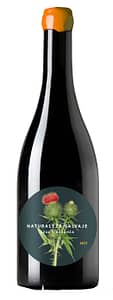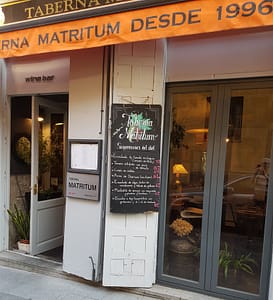In part two I will present just a few highlights among the red wines on the fair. Here you can read about the white wines and some other stuff.
A few words about Rioja: There were many of the old style riojas represented, from crianzas to gran reservas, with their aristocratic names, and gold threads around the heavy bottles. I really have nothing against this style, and once in a while I still enjoy tasting a ‘historic’ wine several decades old. But about this style in general, let me be honest: I have “been there, done that”, as they say. The wine that was selected the best wine of the fair in the high end category was a wine of this sort. I must appologize then, because I didn’t taste it.
I did taste a few riojas though. And in my opinion, what Rioja should do now is what nearly all other regions do, let the vineyards speak, and allow their names to be printed on the labels. If not, dear DOCa. Rioja, you will see many more than Artadi ride away and disappear into the horizon. I will come back to recent Rioja politics in another post. Meanwhile those who are interested can read about a lecture I gave at another Norwegian fair here.
Olivier Rivière is a Frenchman in Rioja (sounds like an echo from the old days maybe, when producers Riscal and Murrieta sought for help and inspiration). Rivière has been a consultant for Telmo Rodríguez, but at the same time he started to buy vineyards. His Rayo Uva 2015 is made predominantly from tempranillo, with some graciano and garnacha grown near Aldeanueva de Ebro, near the Navarra border. It’s a wine made in a natural way, low sulphur, and it has some carbonic. I was tempted to say it has a wild or raw fruitiness, with emphasize on blackberries, cherries, a slight balsamic touch, and it’s as usual very drinkable with a lovely acidity from high altutude vineyards.
Rodríguez himself was also represented by his cheapest rioja wine. When I last visited him in Ollauri he was making the unoaked, fruity, blackberry-focused LZ (here in 2013 vintage) in a very modest winery, and the grapes were partly from Ollauri, partly higher up in Lantziego in the ascendent to the Sierra Cantabria. As I understand at least in 2015 there are only Lantziego grapes used. As you understand both LZ and the Lanzaga wine names (not represented at the fair) are inspired from Basque for the Lanciego village. Only bush wines, handpicked grapes, vineyard selection, only native yeast, fermentation and maturing in cement tanks… Quite unusual for a “commercial” entry-level wine!
All right, I admit that I also tasted the Barón de Chirel 2011, from the historic Marqués de Riscal bodega, as if only to greet an old friend. This was maybe the first of the “high expression” wines that once promised a new dawn for Rioja.
 Óscar Alegre from the Telmo Rodríguez company
Óscar Alegre from the Telmo Rodríguez company
From tempranillo country over to where that beautiful, underestimated garnacha grape is queen. Sierra de Gredos is a mountainous country in the border-zone between three regions, Madrid, Castilla-La Mancha and Castilla y León. This region, where once the first of the “paradores” (the state-owned tourist hotels) was opened, is now working towards a DO Cebreros, named after one of its villages. I had the pleasure to travel around this area together with Alfredo Maestro, leader of the Garnachas de Gredos group during a few winter days two years ago, when the termometer showed -13 Celcius in his own vineyard in the Ávila province.
On this trip I met Dani Landi and his Comando G (for garnacha) collegues. The wines from these people have a truly original interpretation of the grape. They would maybe deny this, as they believe they are just bringing out what the terroir and the grapes comand. Anyway, the wines are always highly expressive, often light in colour, very floral and smells of red berries and with a lovely acidity. Las Uvas de Ira 2014 (Daniel Landi-Jiménez) and Rozas 1er Cru Garnacha 2015 (Comando G) were both among the absolute highlights of the fair. Producer Bernabeleva’s wines (sourced from San Martin de Valdeiglesias village, Madrid) are generally less “wild”, though there is a bear on some of the labels. The Navaherreros Tinto 2014 shown here was quite light in colour, ruby red, with super fruit dominated by dark berries and some spice, and with a mineral aftertaste. Telmo Rodríguez is present in Gredos too, in fact I don’t think it’s wrong to say that he has paved the way for the other producers we talk about. He makes two versions for his Pegaso label in Cebreros, one for each of the predominant soils in the area, granite and slate (‘pizarra’ in Spanish). The Pegaso Granito 2010 is somewhat darker than Landi’s wines, but still only cherry red, with lots of red fruits, fine tannins, generous alcohol and a mineral aftertaste. It’s worth noting that the garnachas from Gredos is quite different from the ones from Aragón/Navarra and the montainous parts of Catalunya.

Enjoying the moment in the busy, bustling atmosphere
Speaking of Catalunya, Terroir al Límit of Torroja, Priorat made a lasting impression, for the reds just like their white wines. They presented two wines made in exactly the same way in 2013: cariñena, old vines (80-90 years), two years in old oak. The only difference was exposition, whereas the Arbossar is from south-faced vineyards the Dits del Terra is north-faced. While they shared many of the characteristics, red berries, flowers, some balsamic notes and minerality, the latter clearly showed a cooler style. Les Tosses 2013 was the most expensive wine, way above the rest at NOK 1.300 (150€/125£). At this point it was quite reductive and needed air, but one could sense both flowers, dark fruits and some balsamic underneath. In the mouth it was powerful, but not overwhelming. So seen in context with the high quality of the rest of their line, I have no reason not to believe that this will be very good indeed.
 Luís Romero with Ivan Zednik of importer Vinarius
Luís Romero with Ivan Zednik of importer Vinarius
From the interior of Galicia we must talk about a couple of wines. Dominio do Bibei is located in Bibei subzone of Ribeira Sacra. This project started some 15 years ago when a group of enthusiasts came together to join forces. They found this wonderful place with chestnuts and oaks, lavenders and chamomile, vegetation that can be brought back to memory once smelling the wine. They did not want a monoculture based on mencía. In respect of their predecessors they opted for a blend of indigenous varieties, so that they could add complexity and elegance to the mencía. And with a range from 200 to 700 meters there are optimal conditions for all of them. Their Lalama 2012 is made from mencía, with a 10% of garnacha (the garnacha tintorera/ alicante bouschet version, I think). I often find that mencía alone too has more freshness here compared to the ones over the Castilian border in Bierzo, maybe it’s because of the Atlantic influence, and many of the vineyards are high uphill too. This wine is a little spicy and shows some trace of wood, but it’s by no means heavy, and has an appealing acidity.
While I have known this wine through some vintages the next one was new to me. Just 30 minutes up the Bibei river we enter into the small community of Santa Cruz within the Valdeorras DO. It has a similar approach, and it’s again Telmo Rodríguez (who deserves a special prize for bringing out wonderful wines from so many regions). As Cabarcas 2013 (T. Rodríguez): one of the revelations of the fair. I know Telmo, I know Valdeorras, and I know that he’s working there. I knew about the red and white Gaba do Xil, but this one – no. And what a wine! Dark, blueish, young, fresh, natural, very luscious, great drinking! The vineyard has many of the same grapes that Dominio do Bibei posesses, and here they are present in the blend too: mencía, merenzao, sousón, garnacha, brancallao, and even the white godello.
From Jumilla (Murcia) there was a wine from non-grafted rootstocks (there are some of this kind in Jumilla, we have also known Julia Roch’s version for many years). The grapes for Pie Franco Monastrell 2015 (Altamente Vinos) are grown 900 meters above sea level. The wine is a typical young monastrell; dark and blueish, spicy, with hints of both dark berries and is a real mouthful. Aged in concrete it’s free from disturbing oak too. One of the people behind Altamente is Fernando Barrena, from Navarra and one of the key-figures behind the company Azul y Garanza. They were represented at the fair too, with two wines, among them the always fruity and lively Fiesta de Azul y Garanza, now in the 2015 vintage. One red from the islands, namely Tenerife: 7 Fuentes (Soagranorte, aka Suertes del Marqués), has been a favourite during the last few years. The 2014, from 110 years old listán negro vines in the cool Orotava valley, aged in cement, is as good as ever before: dark and red berries, flowers, herbs, it’s a little peppery too, a lusicious, fruity taste that rounds off with a volcanic minerality and a charming acidity.
 Many happy faces in Stavanger. No wonder!
Many happy faces in Stavanger. No wonder!








 Many happy faces in Stavanger. No wonder!
Many happy faces in Stavanger. No wonder!